
1
© 2004 by Catalyst Semiconductor, Inc.
Characteristics subject to change without notice.
Doc. No. 1054, Rev. G
HA
LOGEN FREE
TM
LEAD FREE
CAT24FC16
16-kb I
2
C Serial EEPROM
* Catalyst Semiconductor is licensed by Philips Corporation
to carry the I
2
C Bus Protocol.
PIN CONFIGURATION
BLOCK DIAGRAM
PIN FUNCTIONS
Pin Name
Function
NC
No Connect
SDA
Serial Data/Address
SCL
Serial Clock
WP
Write Protect
V
CC
1.8 V to 5.5 V Power Supply
V
SS
Ground
DIP Package (P, L)
TSSOP Package (U, Y)
SOIC Package (J, W)
FEATURES
I
400 kHz (2.5 V) and 100 kHz (1.8 V) I
2
C bus
compatible
I
1.8 to 5.5 volt operation
I
Low power CMOS technology
I
16-byte page write buffer
I
Industrial and extended temperature ranges
I
Self-timed write cycle with auto-clear
I
1,000,000 program/erase cycles
I
100 year data retention
I
8-pin DIP, 8-pin SOIC, 8-pin TSSOP, 8-pin MSOP
and TDFN packages
- "Green" package option available
I
256 x 8 memory organization
I
Hardware write protect
DESCRIPTION
The CAT24FC16 is a 16-kb Serial CMOS EEPROM
internally organized as 2048 words of 8 bits each.
Catalyst's advanced CMOS technology substantially
reduces device power requirements. The CAT24FC16
features a 16-byte page write buffer. The device operates
via the I
2
C bus serial interface and is available in 8-pin
DIP, 8-pin SOIC, 8-pin TSSOP, 8-pin MSOP and TDFN
packages.
DOUT
ACK
SENSE AMPS
SHIFT REGISTERS
CONTROL
LOGIC
WORD ADDRESS
BUFFERS
START/STOP
LOGIC
STATE COUNTERS
E
2
PROM
VCC
EXTERNAL LOAD
COLUMN
DECODERS
XDEC
DATA IN STORAGE
HIGH VOLTAGE/
TIMING CONTROL
VSS
SCL
SDA
WP
TDFN Package (RD4, ZD4)
8
7
6
5
1
2
3
4
NC
NC
NC
VSS
VCC
WP
SCL
SDA
1
2
3
4
8
7
6
5
NC
NC
NC
VSS
VCC
WP
SCL
SDA
MSOP Package (R, Z)
VCC
WP
SCL
SDA
1
2
3
4
8
7
6
5
1
2
3
4
8
7
6
5
VCC
WP
SCL
SDA
NC
NC
NC
VSS
NC
NC
NC
VSS
8
7
6
5
VCC
WP
SCL
SDA
1
2
3
4
NC
NC
NC
VSS
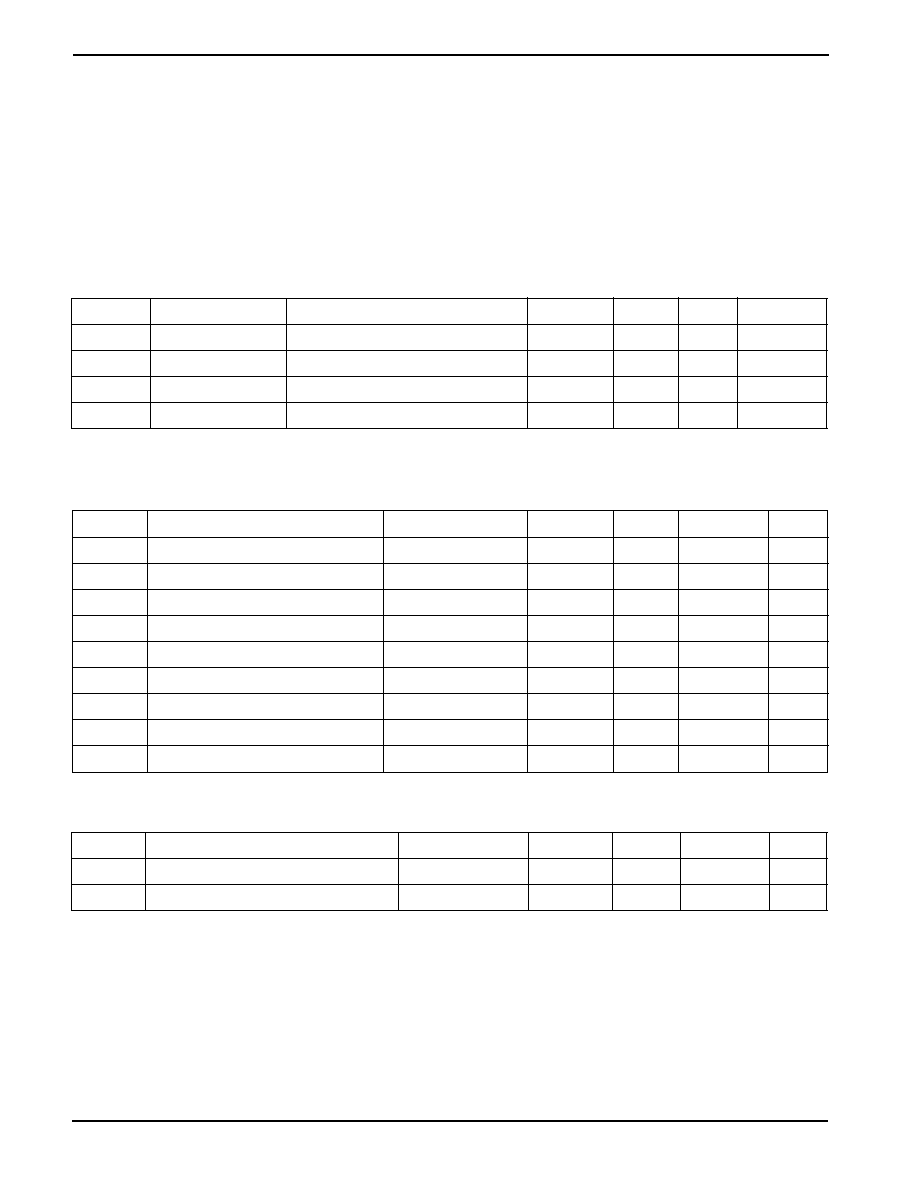
CAT24FC16
2
Doc. No. 1054, Rev. G
CAPACITANCE T
A
= 25
∞C, f = 400 kHz, V
CC
= 5 V
Symbol
Test
Conditions
Min
Typ
Max
Units
C
I/O
(3)
Input/Output Capacitance (SDA)
V
I/O
= 0 V
8
pF
C
IN
(3)
Input Capacitance (other pins)
V
IN
= 0 V
6
pF
RELIABILITY CHARACTERISTICS
Symbol
Parameter
Reference Test Method
Min
Typ
Max
Units
N
END
(3)
Endurance
MIL-STD-883, Test Method 1033
1,000,000
Cycles/Byte
T
DR
(3)
Data Retention
MIL-STD-883, Test Method 1008
100
Years
V
ZAP
(3)
ESD Susceptibility
MIL-STD-883, Test Method 3015
4000
Volts
I
LTH
(3)(4)
Latch-up
JEDEC Standard 17
100
mA
ABSOLUTE MAXIMUM RATINGS*
Temperature Under Bias
≠55
∞C to +125∞C
Storage Temperature ....................... ≠65
∞C to +150∞C
Voltage on Any Pin with
Respect to Ground
(1)
............ ≠2.0 V to V
CC
+ 2.0 V
V
CC
with Respect to Ground ............. ≠2.0 V to +7.0 V
Package Power Dissipation
Capability (T
A
= 25
∞C) .................................. 1.0 W
Note:
(1) The minimum DC input voltage is ≠0.5 V. During transitions, inputs may undershoot to ≠2.0 V for periods of less than 20 ns. Maximum DC
voltage on output pins is V
CC
+ 0.5 V, which may overshoot to V
CC
+ 2.0 V for periods of less than 20 ns.
(2) Output shorted for no more than one second. No more than one output shorted at a time.
(3) This parameter is tested initially and after a design or process change that affects the parameter.
(4) Latch-up protection is provided for stresses up to 100 mA on address and data pins from ≠1.0 V to V
CC
+ 1.0 V.
(5) Maximum standby current (I
SB
) = 10
µA for the Extended Automotive temperature range.
D.C. OPERATING CHARACTERISTICS
V
CC
= 1.8 V to 5.5 V, unless otherwise specified.
Symbol
Parameter
Test Conditions
Min
Typ
Max
Units
I
CC
Power Supply Current (Read)
f
SCL
= 100 kHz
1
mA
I
CC
Power Supply Current (Write)
f
SCL
= 100 kHz
3
mA
I
SB
(5)
Standby Current (V
CC
= 5.0 V)
V
IN
= GND or V
CC
1
µA
I
LI
Input Leakage Current
V
IN
= GND to V
CC
1
µA
I
LO
Output Leakage Current
V
OUT
= GND to V
CC
1
µA
V
IL
Input Low Voltage
≠1
V
CC
x 0.3
V
V
IH
Input High Voltage
V
CC
x 0.7
V
CC
+ 1.0
V
V
OL1
Output Low Voltage (V
CC
= 3.0 V)
I
OL
= 3 mA
0.4
V
V
OL2
Output Low Voltage (V
CC
= 1.8 V)
I
OL
= 1.5 mA
0.5
V
Lead Soldering Temperature (10 seconds) ...... 300
∞C
Output Short Circuit Current
(2)
....................... 100 mA
*COMMENT
Stresses above those listed under "Absolute Maximum Ratings" may
cause permanent damage to the device. These are stress ratings only,
and functional operation of the device at these or any other conditions
outside of those listed in the operational sections of this specification is not
implied. Exposure to any absolute maximum rating for extended periods
may affect device performance and reliability.
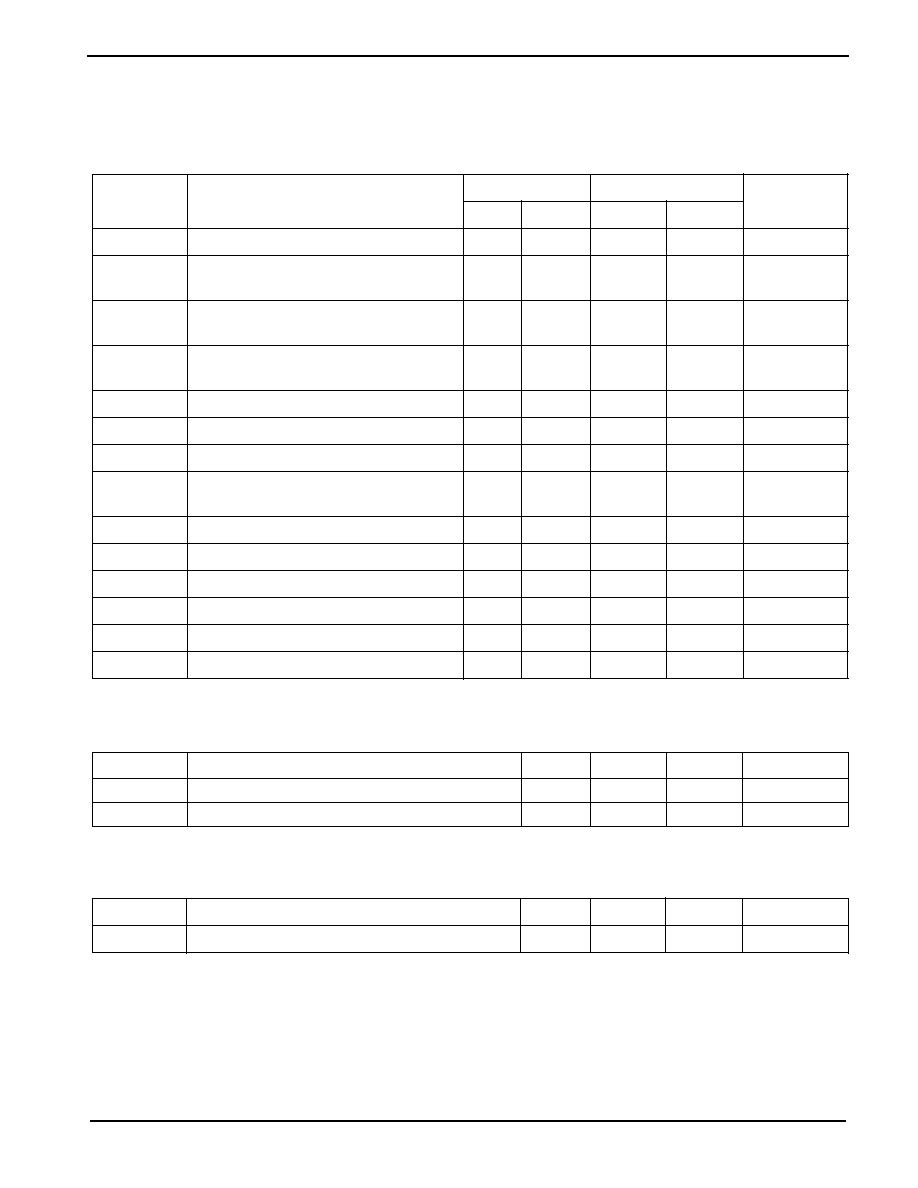
CAT24FC16
3
Doc No. 1054, Rev. G
Write Cycle Limits
Symbol
Parameter
MinTyp
Max
Un
its
t
WR
Write Cycle Time
5
ms
A.C. CHARACTERISTICS
V
CC
= 1.8 V to 5.5 V, unless otherwise specified.
Read & Write Cycle Limits
Symbol
Parameter
1.8 V - 5.5 V
2.5 V - 5.5 V
MinMax
Min Max
Un
its
F
SCL
Clock Frequency
100
400
kHz
T
I
(1)
Noise Suppression Time
100
100
ns
Constant at SCL, SDA Inputs
t
AA
SCL Low to SDA Data Out
3.5
0.9
µs
and ACK Out
t
BUF
(1)
Time the Bus Must be Free Before
4.7
1.3
µs
a New Transmission Can Start
t
HD:STA
Start Condition Hold Time
4
0.6
µs
t
LOW
Clock Low Period
4.7
1.3
µs
t
HIGH
Clock High Period
4
0.6
µs
t
SU:STA
Start Condition Setup Time
4.7
0.6
µs
(for a Repeated Start Condition)
t
HD:DAT
Data In Hold Time
0
0
ns
t
SU:DAT
Data In Setup Time
250
100
ns
t
R
(1)
SDA and SCL Rise Time
1
0.3
µs
t
F
(1)
SDA and SCL Fall Time
300
300
ns
t
SU:STO
Stop Condition Setup Time
4
0.6
µs
t
DH
Data Out Hold Time
100
100
ns
Note:
(1) This parameter is tested initially and after a design or process change that affects the parameter.
(2) t
PUR
and t
PUW
are the delays required from the time V
CC
is stable until the specified operation can be initiated.
Power-Up Timing
(1)(2)
Symbol
Parameter
MinTyp
Max
Un
its
t
PUR
Power-up to Read Operation
1
ms
t
PUW
Power-up to Write Operation
1
ms
The write cycle time is the time from a valid stop
condition of a write sequence to the end of the internal
program/erase cycle. During the write cycle, the bus
interface circuits are disabled, SDA is allowed to remain
high, and the device does not respond to its slave
address.
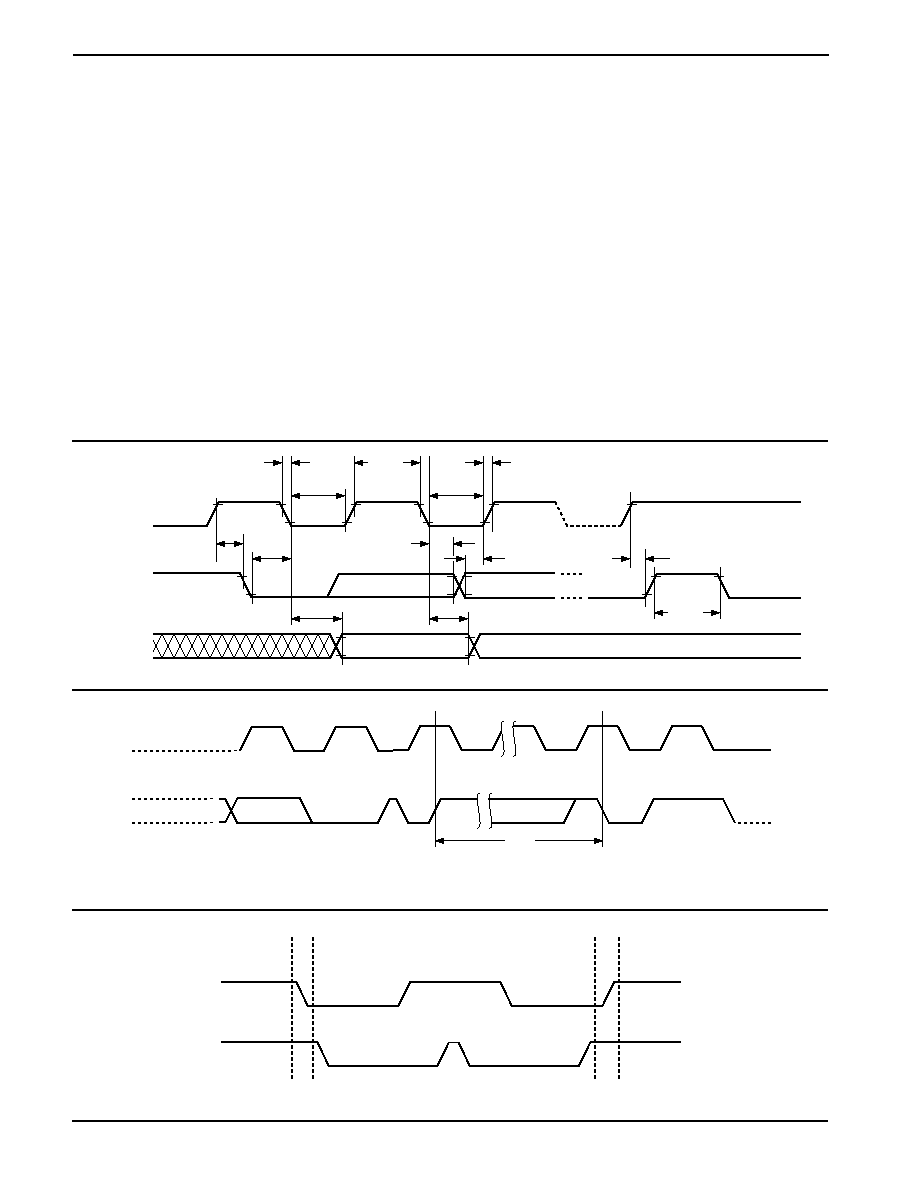
CAT24FC16
4
Doc. No. 1054, Rev. G
FUNCTIONAL DESCRIPTION
The CAT24FC16 supports the I
2
C Bus data transmission
protocol. This Inter-Integrated Circuit Bus protocol defines
any device that sends data to the bus to be a transmitter
and any device receiving data to be a receiver. Data
transfer is controlled by the Master device which
generates the serial clock and all START and STOP
conditions for bus access. The CAT24FC16 operates as
a Slave device. Both the Master and Slave devices can
operate as either transmitter or receiver, but the Master
device controls which mode is activated.
START BIT
SDA
STOP BIT
SCL
Figure 3. Start/Stop Timing
Figure 2. Write Cycle Timing
tWR
STOP
CONDITION
START
CONDITION
ADDRESS
ACK
8TH BIT
BYTE n
SCL
SDA
tHIGH
SCL
SDA IN
SDA OUT
tLOW
tF
tLOW
tR
tBUF
tSU:STO
tSU:DAT
tHD:DAT
tHD:STA
tSU:STA
tAA
tDH
Figure 1. Bus Timing
PIN DESCRIPTIONS
SCL: Serial Clock
The CAT24FC16 serial clock input pin is used to clock all
data transfers into or out of the device. This is an input
pin.
SDA: Serial Data/Address
The CAT24FC16 bidirectional serial data/address pin is
used to transfer data into and out of the device. The SDA
pin is an open drain output and can be wire-ORed with
other open drain or open collector outputs.
WP: Write Protect
This input, when tied to GND, allows write operations to
the entire memory. For CAT24FC16 when this pin is tied
to V
CC
, the entire array of memory is write protected.
When left floating, memory is unprotected.
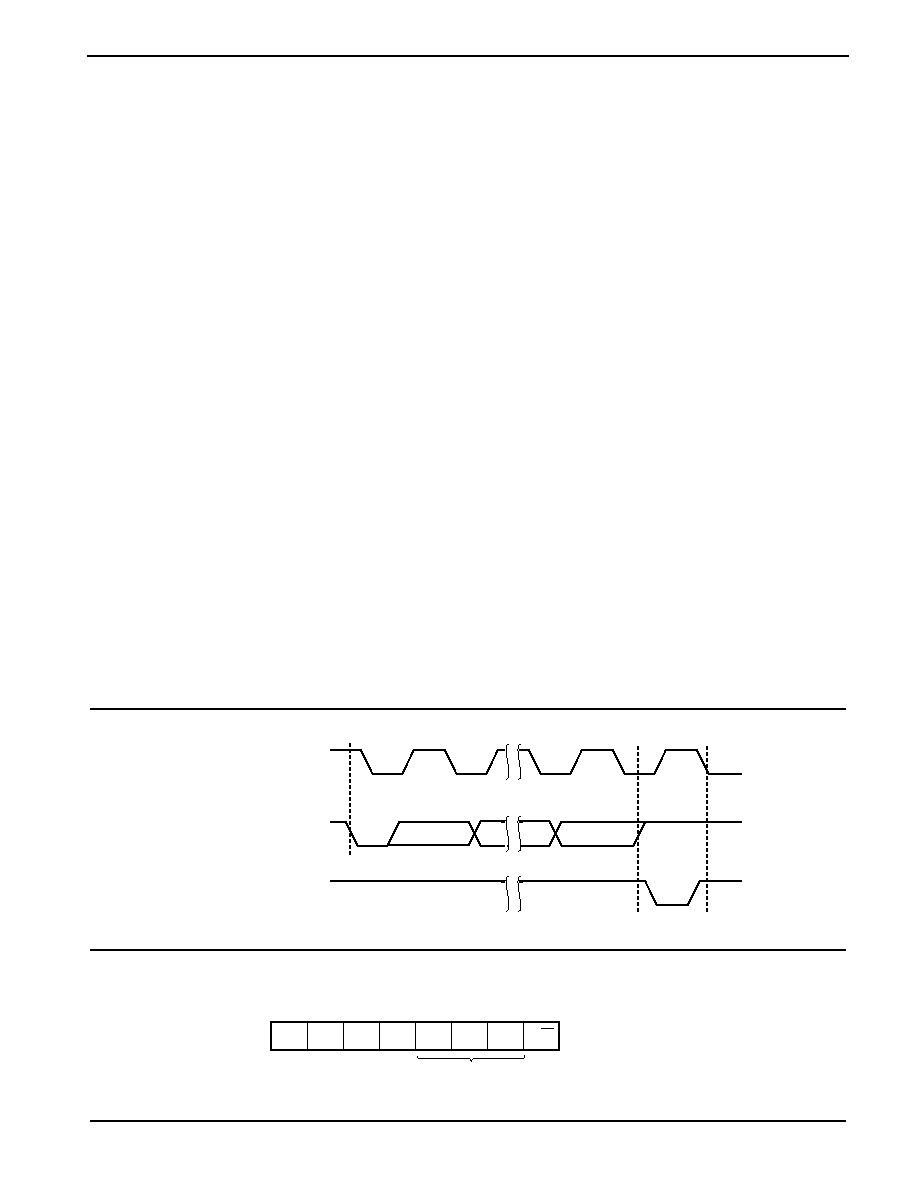
CAT24FC16
5
Doc No. 1054, Rev. G
I
2
C BUS PROTOCOL
The following defines the features of the I
2
C bus proto-
col:
(1) Data transfer may be initiated only when the bus is
not busy.
(2) During a data transfer, the data line must remain
stable whenever the clock line is high. Any changes
in the data line while the clock line is high will be
interpreted as a START or STOP condition.
START Condition
The START Condition precedes all commands to the
device, and is defined as a HIGH to LOW transition of
SDA when SCL is HIGH. The CAT24FC16 monitor the
SDA and SCL lines and will not respond until this
condition is met.
STOP Condition
A LOW to HIGH transition of SDA when SCL is HIGH
determines the STOP condition. All operations must end
with a STOP condition.
DEVICE ADDRESSING
The Master begins a transmission by sending a START
condition. The Master then sends the address of the
particular slave device it is requesting. The four most
significant bits of the 8-bit slave address are fixed as
1010 for the CAT24FC16 (see Fig. 5). The next three
significant bits (A10, A9, A8) are the memory array
address bits. The last bit of the slave address specifies
whether a Read or Write operation is to be performed.
When this bit is set to 1, a Read operation is selected,
and when set to 0, a Write operation is selected.
After the Master sends a START condition and the slave
address byte, the CAT24FC16 monitors the bus and
responds with an acknowledge (on the SDA line) when
its address matches the transmitted slave address. The
CAT24FC16 then performs a Read or a Write operation
depending on the state of the R/
W bit.
Acknowledge
After a successful data transfer, each receiving device is
required to generate an acknowledge. The Acknowledg-
ing device pulls down the SDA line during the ninth clock
cycle, signaling that it received the 8 bits of data.
The CAT24FC16 responds with an acknowledge after
receiving a START condition and its slave address. If the
device has been selected along with a write operation,
it responds with an acknowledge after receiving each
byte.
When the CAT24FC16 begins a READ mode, it trans-
mits 8 bits of data, releases the SDA line, and monitors
the line for an acknowledge. Once it receives this ac-
knowledge, the CAT24FC16 will continue to transmit
data. If no acknowledge is sent by the Master, the device
terminates data transmission and waits for a STOP
condition.
Figure 4. Acknowledge Timing
Figure 5. Slave Address Bits
ACKNOWLEDGE
1
START
SCL FROM
MASTER
8
9
DATA OUTPUT
FROM TRANSMITTER
DATA OUTPUT
FROM RECEIVER
1
DEVICE ADDRESS
0
1
0
A10
A9
A8
R/W
Normal Read and Write
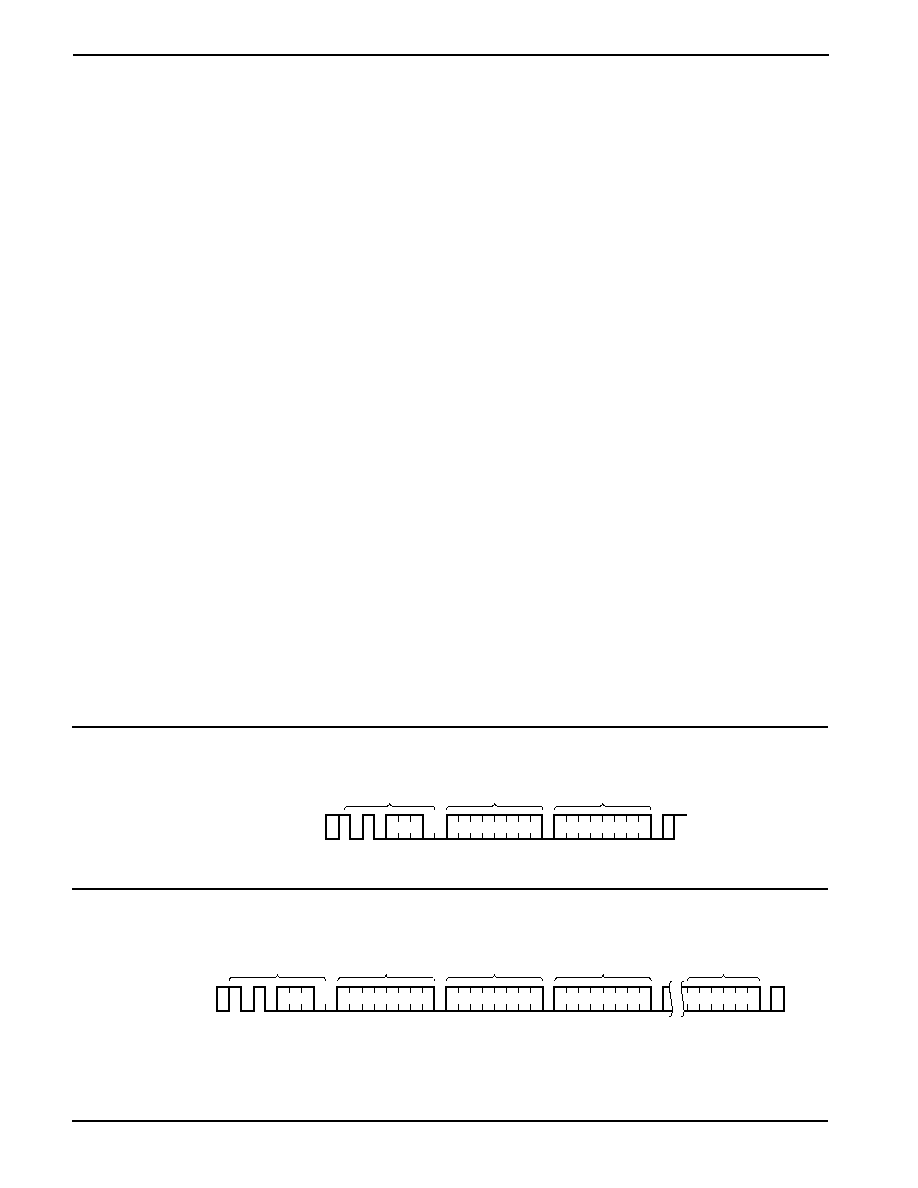
CAT24FC16
6
Doc. No. 1054, Rev. G
WRITE OPERATIONS
Byte Write
In the Byte Write mode, the Master device sends the
START condition and the slave address information
(with the R/
W bit set to zero) to the Slave device. After
the Slave generates an acknowledge, the Master sends
the byte address that is to be written into the address
pointer of the CAT24FC16. After receiving another
acknowledge from the Slave, the Master device transmits
the data byte to be written into the addressed memory
location. The CAT24FC16 acknowledges once more
and the Master generates the STOP condition, at which
time the device begins its internal programming to
nonvolatile memory. While this internal cycle is in
progress, the device will not respond to any request from
the Master device.
Page Write
The CAT24FC16 writes up to 16 bytes of data in a single
write cycle, using the Page Write operation. The Page
Write operation is initiated in the same manner as the
Byte Write operation, however instead of terminating
after the initial word is transmitted, the Master is allowed
to send up to 15 additional bytes. After each byte has
been transmitted the CAT24FC16 will respond with an
acknowledge, and internally increment the low order
address bits by one. The high order bits remain
unchanged.
If the Master transmits more than 16 bytes prior to
sending the STOP condition, the address counter `wraps
around', and previously transmitted data will be
overwritten.
Once all 16 bytes are received and the STOP condition
has been sent by the Master, the internal programming
cycle begins. At this point all received data is written to
the CAT24FC16 in a single write cycle.
Acknowledge Polling
The disabling of the inputs can be used to take advantage
of the typical write cycle time. Once the stop condition
is issued to indicate the end of the host's write operation,
the CAT24FC16 initiates the internal write cycle. ACK
polling can be initiated immediately. This involves
issuing the start condition followed by the slave address
for a write operation. If the CAT24FC16 is still busy with
the write operation, no ACK will be returned. If the
CAT24FC16 has completed the write operation, an ACK
will be returned and the host can then proceed with the
next read or write operation.
WRITE PROTECTION
The CAT24FC16 is designed with a hardware protect
pin that enables the user to protect the entire memory.
The hardware protection feature of the CAT24FC16 is
designed into the part to provide added flexibility to the
design engineers. The write protection feature of
CAT24FC16 allows the user to protect against inadvertent
programming of the memory array. If the WP pin is tied
to Vcc, the entire memory array is protected and becomes
read only. The entire memory becomes write protected
regardless of whether the write protect register has been
written or not. When WP pin is tied to Vcc, the user
cannot program the write protect register. If the WP pin
is left floating or tied to Vss, the device can be written
into.
Figure 7. Page Write Timing
BYTE
ADDRESS
SLAVE
ADDRESS
S
DATA
S
T
O
P
P
BUS ACTIVITY:
MASTER
SDA LINE
S
T
A
R
T
BUS ACTIVITY:
MASTER
SDA LINE
DATA n+P
BYTE
ADDRESS (n)
A
C
K
A
C
K
DATA n
A
C
K
S
T
O
P
S
A
C
K
DATA n+1
A
C
K
S
T
A
R
T
P
SLAVE
ADDRESS
NOTE: IN THIS EXAMPLE n = XXXX 0000(B); X = 1 or 0
*
Figure 6. Byte Write Timing

CAT24FC16
7
Doc No. 1054, Rev. G
Read Operations
The READ operation for the CAT24FC16 is initiated in
the same manner as the write operation with the one
exception that the R/
W bit is set to a one. Three different
READ operations are possible: Immediate Address
READ, Selective READ and Sequential READ.
Immediate Address Read
The CAT24FC16's address counter contains the address
of the last byte accessed, incremented by one. In other
words, if the last READ or WRITE access was to address
N, the READ immediately following would access data
from address N + 1. If N = 2047 for 24FC16, then the
counter will `wrap around' to address 0 and continue to
clock out data. After the CAT24FC16 receives its slave
address information (with the R/
W bit set to one), it
issues an acknowledge, then transmits the 8-bit byte
requested. The master device does not send an
acknowledge but will generate a STOP condition.
Selective Read
Selective READ operations allow the Master device to
select at random any memory location for a READ
operation. The Master device first performs a `dummy'
write operation by sending the START condition, slave
address and byte address of the location it wishes to
read. After the CAT24FC16 acknowledge the word
address, the Master device resends the START condition
and the slave address, this time with the R/
W bit set to
one. The CAT24FC16 then responds with its
acknowledge and sends the 8-bit byte requested. The
master device does not send an acknowledge but will
generate a STOP condition.
Sequential Read
The Sequential READ operation can be initiated by
either the Immediate Address READ or Selective READ
operations. After the CAT24FC16 sends the initial 8-bit
data requested, the Master will respond with an
acknowledge which tells the device it requires more
data. The CAT24FC16 will continue to output a byte for
each acknowledge sent by the Master. The operation
will terminate operation when the Master fails to respond
with an acknowledge, thus sending the STOP condition.
The data being transmitted from the CAT24FC16 is
outputted sequentially with data from address N followed
by data from address N + 1. The READ operation
address counter increments all of the CAT24FC16
address bits so that the entire memory array can be read
during one operation. If more than the 2047 bytes are
read out, the counter will "wrap around" and continue to
clock out data bytes.
Figure 8. Immediate Address Read Timing
SCL
9
8
SDA
8TH BIT
STOP
NO ACK
DATA OUT
SLAVE
ADDRESS
S
A
C
K
DATA
N
O
A
C
K
S
T
O
P
P
BUS ACTIVITY:
MASTER
SDA LINE
S
T
A
R
T
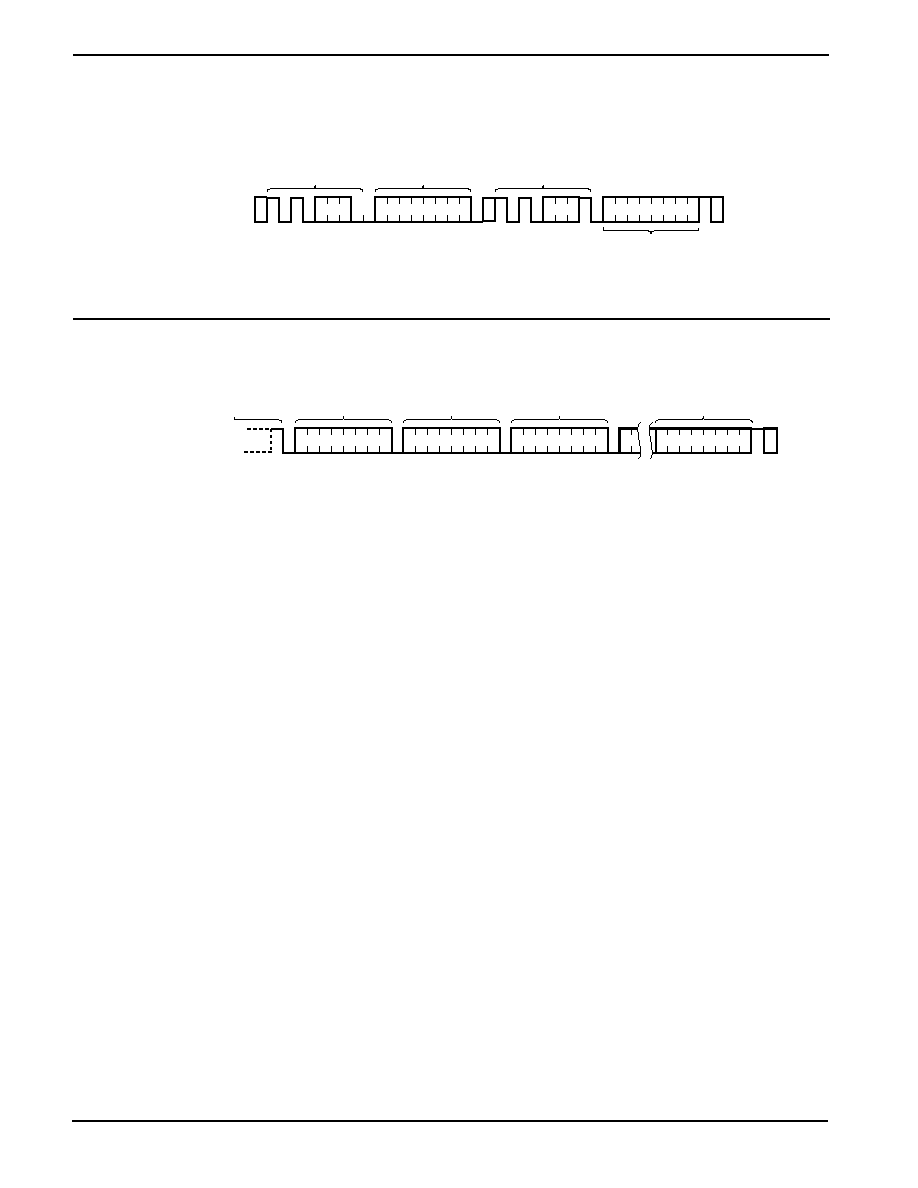
CAT24FC16
8
Doc. No. 1054, Rev. G
Figure 9. Selective Read Timing
Figure 10. Sequential Read Timing
SLAVE
ADDRESS
S
A
C
K
N
O
A
C
K
S
T
O
P
P
BUS ACTIVITY:
MASTER
SDA LINE
S
T
A
R
T
BYTE
ADDRESS (n)
S
A
C
K
DATA n
SLAVE
ADDRESS
A
C
K
S
T
A
R
T
BUS ACTIVITY:
MASTER
SDA LINE
DATA n+x
DATA n
A
C
K
A
C
K
DATA n+1
A
C
K
S
T
O
P
N
O
A
C
K
DATA n+2
A
C
K
P
SLAVE
ADDRESS
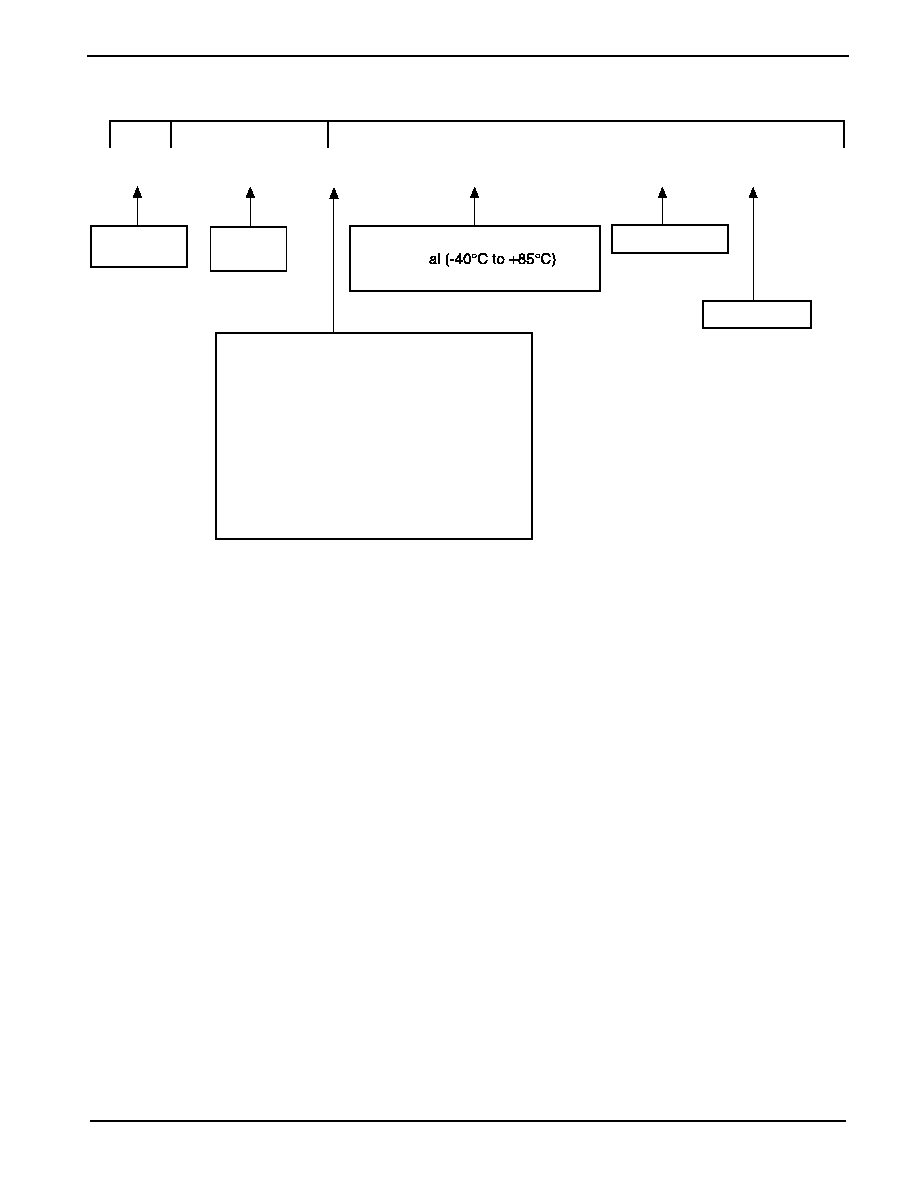
CAT24FC16
9
Doc No. 1054, Rev. G
ORDERING INFORMATION
Notes:
(1) The device used in the above example is a 24FC16JI-TE13 (SOIC, Industrial Temperature, 1.8 Volt to 5.5 Volt Operating Voltage, Tape & Reel)
Prefix
Device #
Suffix
24FC16
J
I
Product
Number
Package
CAT
Temperature Range
I = Indust ri
Optional
Company ID
E = Extended (-40
∞C to +125∞C)
P: PDIP
J: SOIC (JEDEC)
R: MSOP
U: TSSOP
RD4: TDFN
L: PDIP (Lead free, Halogen free)
W: SOIC (JEDEC), (Lead free, Halogen free)
Y: TSSOP (Lead free, Halogen free)
Z: MSOP (Lead free, Halogen free)
ZD4: TDFN (Lead free, Halogen free)
TE13
Tape & Reel
REV-F
Die Revision

CAT24FC16
10
Doc. No. 1054, Rev. G
REVISION HISTORY
e
t
a
D
n
o
i
s
i
v
e
R
s
t
n
e
m
m
o
C
3
0
/
8
1
/
1
1
A
e
u
s
s
I
l
a
i
t
i
n
I
3
0
/
9
0
/
2
1
B
g
n
i
r
e
d
r
o
n
i
"
k
n
a
l
B
"
m
o
r
f
"
I
"
o
t
p
m
e
T
l
a
i
r
t
s
u
d
n
I
d
e
g
n
a
h
C
n
o
i
t
a
m
r
o
f
n
i
4
0
/
0
1
/
3
0
C
o
f
n
i
g
n
i
r
e
d
r
o
N
F
D
T
d
e
t
c
e
r
r
o
C
4
0
/
2
0
/
4
0
D
n
o
i
t
a
n
g
i
s
e
d
t
e
e
h
s
a
t
a
d
d
e
t
a
n
i
m
il
E
"
n
o
i
t
c
e
t
o
r
P
e
t
i
r
W
"
n
i
r
e
t
s
i
g
e
r
t
c
e
t
o
r
p
e
t
i
r
w
a
o
t
e
c
n
e
r
e
f
e
r
d
e
v
o
m
e
R
4
0
/
5
1
/
5
0
E
s
c
i
t
s
i
r
e
t
c
a
r
a
h
C
g
n
i
t
a
r
e
p
O
.
C
.
D
s
t
i
m
i
L
e
l
c
y
C
e
t
i
r
W
n
o
i
t
a
m
r
o
f
n
I
g
n
i
r
e
d
r
O
e
t
a
d
p
U
y
r
o
t
s
i
H
n
o
i
s
i
v
e
R
e
t
a
d
p
U
r
e
b
m
u
N
v
e
R
e
t
a
d
p
U
4
0
/
7
0
/
6
0
F
s
t
i
m
i
L
e
l
c
y
C
e
t
i
r
W
e
t
a
d
p
U
4
0
/
7
2
/
7
G
2
e
g
a
p
n
o
s
e
t
o
n
e
t
a
d
p
U

Catalyst Semiconductor, Inc.
Corporate Headquarters
1250 Borregas Avenue
Sunnyvale, CA 94089
Phone: 408.542.1000
Fax: 408.542.1200
www.catalyst-semiconductor.com
Publication #:
1054
Revison:
G
Issue date:
07/27/04
Copyrights, Trademarks and Patents
Trademarks and registered trademarks of Catalyst Semiconductor include each of the following:
DPP TM
DPPs TM
AE
2
TM
Catalyst Semiconductor has been issued U.S. and foreign patents and has patent applications pending that protect its products. For a complete list of patents
issued to Catalyst Semiconductor contact the Company's corporate office at 408.542.1000.
CATALYST SEMICONDUCTOR MAKES NO WARRANTY, REPRESENTATION OR GUARANTEE, EXPRESS OR IMPLIED, REGARDING THE SUITABILITY OF ITS
PRODUCTS FOR ANY PARTICULAR PURPOSE, NOR THAT THE USE OF ITS PRODUCTS WILL NOT INFRINGE ITS INTELLECTUAL PROPERTY RIGHTS OR THE
RIGHTS OF THIRD PARTIES WITH RESPECT TO ANY PARTICULAR USE OR APPLICATION AND SPECIFICALLY DISCLAIMS ANY AND ALL LIABILITY ARISING
OUT OF ANY SUCH USE OR APPLICATION, INCLUDING BUT NOT LIMITED TO, CONSEQUENTIAL OR INCIDENTAL DAMAGES.
Catalyst Semiconductor products are not designed, intended, or authorized for use as components in systems intended for surgical implant into the body, or
other applications intended to support or sustain life, or for any other application in which the failure of the Catalyst Semiconductor product could create a
situation where personal injury or death may occur.
Catalyst Semiconductor reserves the right to make changes to or discontinue any product or service described herein without notice. Products with data sheets
labeled "Advance Information" or "Preliminary" and other products described herein may not be in production or offered for sale.
Catalyst Semiconductor advises customers to obtain the current version of the relevant product information before placing orders. Circuit diagrams illustrate
typical semiconductor applications and may not be complete.










